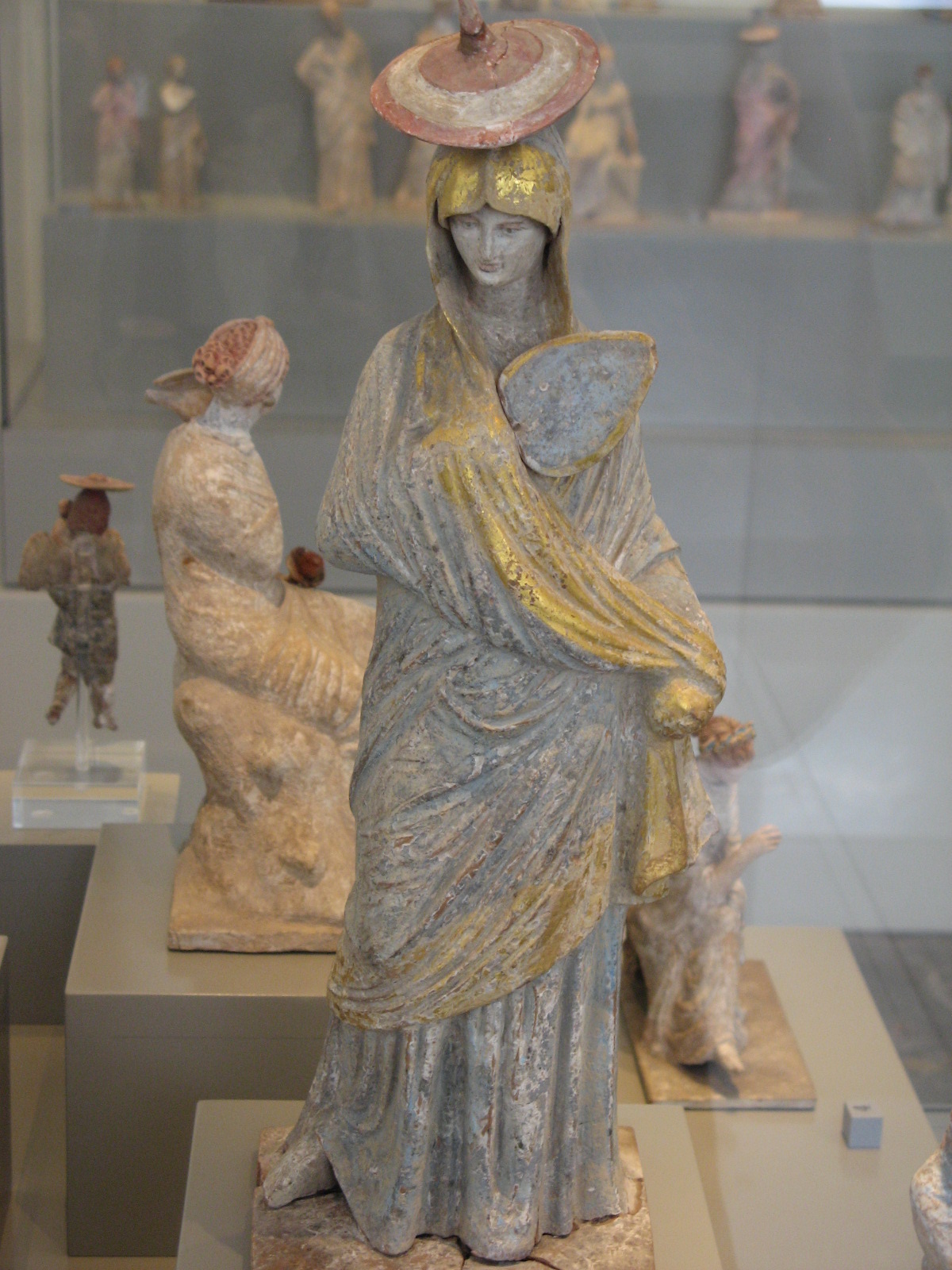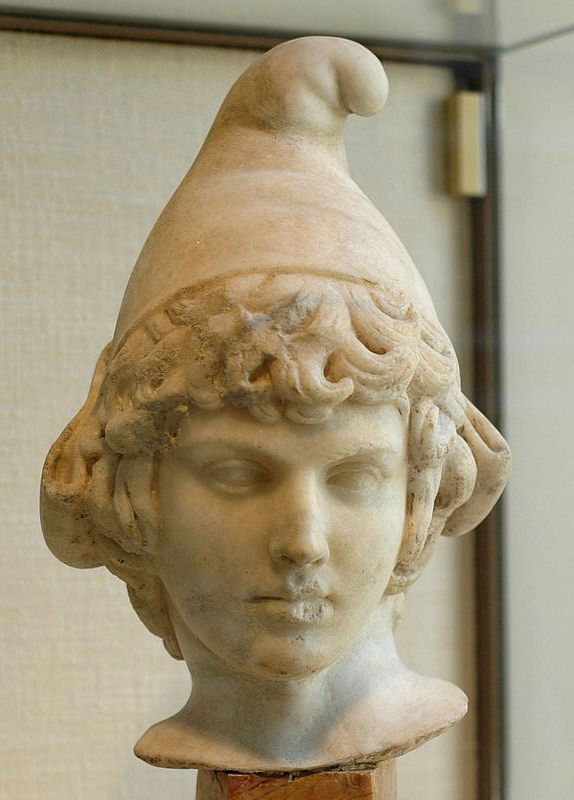.
Lady with blue and gilt garment, fan and sun hat: Tanagra, 325-300 BC (Altes Museum, Berlin; image by Capillon, 2008)
Magna Est Veritas
With my looks I am bound to look simple or fast I would rather look simple
So I wear a tall hat on the back of my head that is rather a temple
And I walk rather queerly and comb my long hair
And people say, Don't bother about her.
So in my time I have picked up a good many facts,
Rather more than the people do who wear smart hats
And I do not deceive because I am rather simple too
And although I collect facts I do not always know what they amount to.
I regard them as a contribution to almighty Truth, magna est veritas et praevalebit,
Agreeing with that Latin writer, Great is Truth and will prevail in a bit.
Florence Margaret "Stevie" Smith (1902-1971): Magna Est Veritas, from Not Waving but Drowning, 1957
Bust of Attis as a child wearing a Phrygian cap: 2nd century AD, probably during the reign of Emperor Hadrian; portrait bears a resemblance to those of Antinous (Cabinet des Médailles, Bibliotheque Nationale de France, Paris; image by Jastrow, 2006)
Magna Est Veritas
Here, in this little Bay,
Full of tumultuous life and great repose,
Where, twice a day,
The purposeless, glad ocean comes and goes,
Under high cliffs, and far from the huge town,
I sit me down.
For want of me the world's course will not fail:
When all its work is done, the lie shall rot;
The truth is great, and shall prevail,
When none cares whether it prevail or not.
Coventry Kersey Dighton Patmore (1823-1896): Magna Est Veritas, from The Unknown Eros, 1890

Decebalus, the Dacian king: rock carving on Trajan's Column, Rome, possibly by Apollodorus of Damascus, 113 AD (image by Bogdan, 2005) 

¡Al fin! Desde hace varios días que no lograba cargar las páginas de tu blog para ver los nuevos posts. Hoy sí que pude =) y disfruté mucho lo que me había perdido.
ReplyDeleteLove this.
ReplyDelete"arcathe"
is that a madrigal? The Patmore? it looks like a madrigal— thanks as always for all your brilliant postings
ReplyDeleteTom - So pleased (and I'll admit a little surprised - but then I shouldn't be, given the generosity of your taste) to see Stevie Smith making an appearance. I rarely feel 'English', not having much idea what being English means, and suspecting that I wouldn't care for it if I did. Enjoying Stevie Smith, though, feels English in a way I can live with, and Truth prevailing 'in a bit' puts what I feel like identifying as an English smile on my face. Remembering, of course, that in Smith, a smile is always likely to be a distress signal.
ReplyDeleteSee you in a bit.
Robb,
ReplyDeleteArcathe. Exactly.
Julia,
Lo siento, por favor, perdóname! He estado trabajando en hacer la entrada un poco más fácil.
Barry,
Delighted we share this taste. Stevie Smith has been dragged through these wastes before:
Stevie Smith: Bog-Face
Stevie Smith: Dirge
Stevie Smith: Lady 'Rogue' Singleton
Stevie Smith: Tenuous and Precarious
Stevie Smith: Thoughts about the Person from Porlock
Bill,
ReplyDeleteHello, and that's interesting.
That amorphous thing the English madrigal seems to be a category at once broad and shallow, of which Patmore's poem, in that it is monostrophic, with lines of mixed syllabic length -- by my count 6/11(10?)/9/10/10/4/9/10/8,10 -- would seem to qualify, both in the antiquarian formal sense and in the feeling of inconsequentiality or triviality... which of course Patmore certainly did not intend but by which Smith was evidently sufficiently annoyed to provoke this wonderful, slightly inimical collaboration with the ghost of poet who died a few years before she was born.
What more harmless way to while away the wee hours than to ponder the nature of the madrigal, which appears to have no intrinsic nature.
Edmund Gosse, 1911: "MADRIGAL (Ital. madrigale), the name of a form of verse, the exact nature of which has never been decided in English."
"The definition given in the New English Dictionary, 'a short lyrical poem of amatory character,'" complains Gosse somewhat sourly, "offers no distinctive formula..."
He then sets out his formula.
Gosse takes as the type of the form the specimens of Drummond of Hawthornden, "serious, brief, irregular lyrics, in which neither the amatory nor the complimentary tone is by any means obligatory... Some of these pieces contain as few as six lines, one as many as fourteen, but they average from nine to eleven. In the majority of examples the little poem opens with a line of six syllables, and no line extends beyond ten syllables. The madrigal appears to be a short canzone of the Tuscan type, but less rigidly constructed."
The Princeton Boke, for its part, has it that by the 16th c. the madrigal: "...had become a very free monostrophic verse form of about a dozen 7-and-11-syllable lines in no fixed order or rhyme scheme, although it usually ended in a couplet."
Princeton cites as a model, from Sidney's Old Arcadia c. 1577-1580, "a 15 line poem of mixed 6-and-10 syllable lines with masculine rhymes."
My favourite authority in this area however is Edward Doughtie, "Lyrics from English Airs, 1596-1622":
"The texts [of English madrigals]," says Doughtie, "are usually single stanzas... the texts are often inconsequential as poetry because their main function was to provide syllable for singing, words simply naming a mood or emotion that the composer could exploit."
Doughtie cites as e.g.
John Dowland: Second Book of Airs, 1600 – Sorrow, stay
Sorrow, stay! lend true repentant tears
To a woeful wretched wight.
Hence, Despair! with thy tormenting fears
O do not my poor heart affright.
Pity, help! now or never;
Mark me not to endless pain.
Alas, I am condemned ever,
No hope, no help there doth remain.
But down, down, down, down I fall
And arise I never shall.
Of course Patmore is flying in the face of the natural lightness of the form by using it not to name an emotion but to, as it were, think.
Madrigals weren't built to do that, I don't think, though Edmund Gosse and Drummond of Hawthornden and Coventry Patmore seem to have thought otherwise.
Oh, no, no, Tom! Of course I didn't mean that. It wasn't your fault! It must be a problem with my internet connection.
ReplyDeletePatmore's madrigal reminds me of "Dover Beach": the sea, the cliffs, the varying line lengths. Unlike Arnold, however, Patmore doesn't explicitly connect the setting to his thoughts with a metaphor like "Sea of Faith." And Patmore is optimistic about the eventual triumph of truth, whereas Arnold is pessimistic. On the other hand, the last stanza of "Dover Beach" abandons the seaside setting and seems a little abstracted from the rest of the poem, so you could say that "Dover Beach" and Patmore's madrigal pivot in a similar way.
ReplyDeleteDavid,
ReplyDeleteSome of the best minds of my generation liked to start their day with a bit of Arnold.
Tom,
ReplyDeleteNIce to find Edward Doughtie invoked here in the comments, and if you want to delve a bit further, check out Thomas Morley's A Plaine and Easie Introduction to Practicall Musicke (1597), along with a few examples from Edmund H. Fellowes' English Madrigal Verse. . . .
I really like that, Tom--like it better than "The Dover Bitch." But I'd like just about any poem with French toast in it. That's my objective correlative of matutinal satiety. (Since we're taking some anachronisms out of mothballs here.)
ReplyDeleteThanks for pointing towards the other Smith posts. I liked being invited to think about SS alongside Henry Green: one thing they do seem to share is an extraordinarily subtle internal dislocation (derangement?) of class dialects, so their characters talk like brilliantly programmed mannequins, just enough off true to signal the weirdness of the normal, the respectable, the 'just so'. Intense pleasure for all anthropologists of Englishness.
ReplyDelete"...their characters talk like brilliantly programmed mannequins, just enough off true to signal the weirdness of the normal..."
ReplyDeleteBarry, that's dead-on.
Formalists of the abnormality hidden within the bland dimensions of the normal.
Tom - I recall, dimly, a comparable effect of dissociation, or estrangement, in the couple of things by Ivy Compton-Burnett that I struggled with thirty years ago, no doubt too callow then to ‘get’ them. With all three writers I feel there’s a sense of being in some kind of post-traumatic environment, but one where everybody is too polite to enquire, even of themselves, what the trauma might have been. Green’s *Back* , is the one I know where this tendency gets *really* weird, and that is explicitly about shell-shock, or battle fatigue, or whatever they were calling then the war men bring home with them.
ReplyDelete"...their characters talk like brilliantly programmed mannequins, just enough off true to signal the weirdness of the normal..."
ReplyDeleteBarry, that's dead-on.
Formalists of the abnormality hidden within the bland dimensions of the normal.